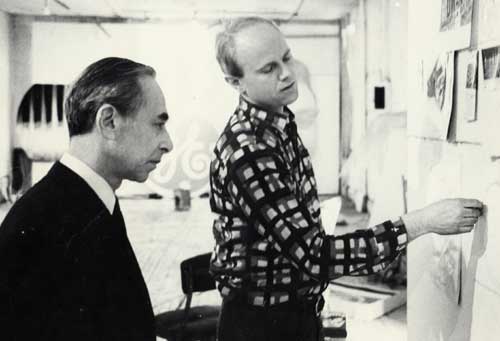
Leo Castelli with James Rosenquist.
Peter Schjeldahl writes a great feature for the New Yorker on legendary dealer Leo Castelli. I consider some of it a bit of a refresher — any book on Castelli will describe his great charm and influence in the art world, particularly in the 50s and 60s — but I found it worth reading all the same. Like many, I’m not exactly a Leo Castelli expert.
To my mind the most interesting details Schjeldahl offers up come during the Soho expansion in the 70’s.
In 1971 came the expansion to SoHo in a five-story building bought with a coöperative of dealers. Castelli took the second floor and the Sonnabend Gallery the third. Ileana outflanked him with a wave of new European artists and outrageous Americans, including Vito Acconci (who, in his performance piece “Seedbed,” hid under a ramp and masturbated while vocally fantasizing, via an amplifier, about the viewers above him). Sales of Johns and Lichtenstein kept Castelli afloat, but, what with production costs for grandiose minimalist and post-minimalist works that sold slowly, if at all, and the never interrupted outlay of stipends, amid a recession, the business was hard put by the time I declined the chance to trigger a Castelligate. Judd left, ending up at the Pace Gallery. Rauschenberg was lured away by the Knoedler Gallery. One after another, gallerists arose, including Mary Boone and Larry Gagosian, who usurped Castelli's primacy even as they voiced tribute to him as a hero. Castelli took it as a “truly poisoned shaft,” Cohen-Solal writes, when, behind his back, Arne Glimcher, of Pace, arranged the watershed million-dollar sale of Johns's “Three Flags” from a private collection to the Whitney Museum, in 1980. Joint shows with Boone, of Julian Schnabel, in 1981, and David Salle, in 1982, amounted to strategic capitulations. Castelli's once mighty business model began to seem almost quaint. For one thing, he rarely worked the secondary market in already owned works, a money machine for Gagosian. Of the top galleries today, only Marian Goodman's hews closely to Castelli's paradigm.
An interesting observation, but I would think D’Amellio Terras, or Anton Kern would fall into this category too (to name just two). Is there something other than the sale of previously owned works that’s informing this statement?
Editor’s note: The blog is going to be a little more spartan than it is usually is today and tomorrow on account of deadlines.


{ 1 comment }
I did not know about this business model, great you told me….Loved ya post.
Free grocery coupons
Comments on this entry are closed.